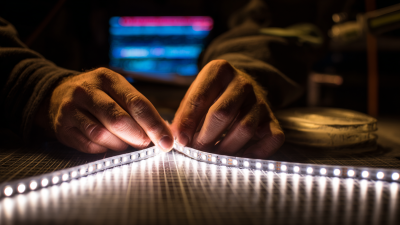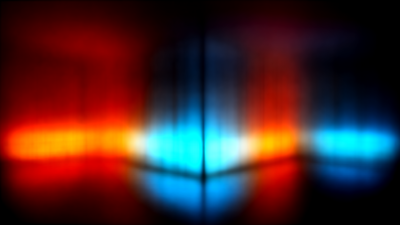Ultimate Guide to LED Strip Light Connectors for a Brighter Home
In recent years, LED strip lights have surged in popularity, becoming a favored choice for residential and commercial lighting solutions due to their energy efficiency and versatility. According to a report by the Lighting Research Center, the global LED lighting market is projected to reach $105 billion by 2025, with LED strip lights constituting a significant portion of this growth. As these products gain traction, so does the importance of understanding the accessories that enhance their functionality, particularly LED strip light connectors.
Renowned lighting expert Dr. Emily Reynolds states, "Proper connection methods are essential for maximizing the lifespan and performance of LED strip lights." This highlights the critical role that LED strip light connectors play in ensuring a seamless and effective lighting design. Whether installing in a home or office, the right connectors can significantly impact both the aesthetic appeal and the operational efficiency of the lighting system. As we delve into the top 10 LED strip light connectors available on the market, we aim to provide insights that will illuminate the path toward a brighter and more vibrant living space.

Understanding LED Strip Light Connectors: Types and Functions
LED strip lights have become a popular choice for modern home lighting due to their versatility and energy efficiency. Understanding the various types of LED strip light connectors is crucial for achieving the desired installation and functionality. These connectors serve as the link between the strips and power sources or other components, facilitating a seamless connection for both aesthetic and practical purposes.
There are several types of connectors available, each designed for specific configurations and requirements. For instance, the standard 2-pin connectors are ideal for basic installations, allowing for simple power connections. On the other hand, 4-pin connectors cater to RGB LED strips, enabling color-changing capabilities. Additionally, terminal blocks provide a reliable option for connecting multiple strips without soldering, making them a favored choice among DIY enthusiasts. Understanding these connectors' functions and applications ensures that you'll be able to create an efficient and beautiful lighting setup in your home.
Ultimate Guide to LED Strip Light Connectors for a Brighter Home - Understanding LED Strip Light Connectors: Types and Functions
| Connector Type | Description | Common Use Cases | Max Load (Amperes) |
|---|---|---|---|
| JST Connector | A compact, reliable connector typically used for low-power LED strips. | Small LED projects, DIY installations. | 3A |
| Molex Connector | A commonly used 4-pin connector providing a stable connection for various devices. | Home automation, computer lighting. | 6A |
| Barricade Connector | A versatile connector that allows for easy disconnection and reconnection of strips. | Lighting setups requiring flexibility, rental events. | 5A |
| Solderless Connector | An easy-to-use connector that does not require soldering, ideal for quick setups. | DIY projects, quick replacements. | 4A |
| Wire-to-Board Connector | A robust connector facilitating easy wiring to PCB connections. | Permanent fixtures, lighting systems. | 8A |
Choosing the Right Connector for Your LED Strip Light Project
When embarking on a LED strip light project, selecting the right connector is crucial for ensuring a seamless and efficient installation. LED connectors come in various types, each designed to fit different LED strip widths and functions. Common options include solderless connectors, which offer a convenient solution for quick attachments, and solder-on connectors for a more permanent and reliable bond. It's important to assess your specific needs based on the installation location and the length of your LED strips.
**Tips:** Before purchasing connectors, measure the width of your LED strips carefully, as connectors typically come in 8mm, 10mm, or 12mm sizes. Additionally, consider using connectors with flexible cables if your lighting design includes curves or angles; this will provide more versatility during installation.
Another key aspect to consider is compatibility with your power supply. Ensure that the connectors you choose can handle the voltage and current required for your LEDs. Investing in quality connectors can prevent flickering and extend the lifespan of your LED lights, enhancing your overall home lighting experience.
**Tips:** Research and read reviews on different connector brands and types to determine which ones perform best within your setup. Don’t hesitate to consult video tutorials online for visual guidance on how to properly install and secure your LED connectors for optimal results.
Installation Tips for Seamless LED Connector Use
When installing LED strip lights, choosing the right can make all the difference in ensuring a seamless and effective setup. Proper installation techniques not only enhance the aesthetics of your lighting but also maximize the functionality of your LED strips. Here are some essential tips for a smooth connector installation.
First, always measure and cut your LED strips accurately to avoid excess waste and ensure connections are precise. Use dedicated connectors that match the strip width—most commonly either 10mm or 8mm—to guarantee a secure fit. When applying connectors, it’s crucial to remove any adhesive backing to expose the copper pads underneath; this will help create a strong electrical connection. By following these steps, you can significantly reduce the chances of flickering or dim lighting.
Another tip is to ensure your connectors are compatible with the voltage rating of your LED strips. Most commonly, 12V or 24V connections are used. Moreover, make sure to check that the connectors are firmly attached and double-check the polarity before powering up your installation. A little care in these details can lead to a flawless, long-lasting illumination that enhances the ambiance of your home.
Common Issues and Troubleshooting for LED Strip Connectors
When working with LED strip light connectors, users often encounter common issues that can impede optimal performance. One frequent problem is poor connectivity, often due to loose or corroded connections. According to a report from the Lighting Research Center, nearly 30% of LED strip light failures are attributed to connection-related issues. Ensuring that connectors are free from dirt and securely attached can significantly reduce the likelihood of these problems.
Another common troubleshooting scenario involves the color mismatch or flickering of lights, which is typically caused by incompatible connectors or poor-quality products. A study published by the U.S. Department of Energy indicates that using high-quality connectors can improve the longevity and performance of LED systems. Users should ensure that their connectors match the specifications of the LED strips being used, including voltage and current ratings. By being aware of these common issues and following best practices in installation, homeowners can greatly enhance their LED lighting experience.
LED Strip Light Connector Issues and Troubleshooting
Enhancing Home Ambiance with LED Strip Light Connectors
LED strip lights have revolutionized the way we illuminate our homes, offering not only brightness but also a plethora of colors and effects that enhance the ambiance of any space. According to a report by Research and Markets, the global LED lighting market is projected to reach $162 billion by 2025, driven in large part by the increasing popularity of LED strip lights in residential settings. These versatile lighting solutions can be easily integrated into various home environments, from cozy living rooms to modern kitchens, allowing homeowners to customize their lighting according to their mood and style.
Central to the effectiveness of LED strip lights are the connectors that facilitate their installation and operation. Quality connectors ensure stable connections and reduce the risk of electrical failure, which is crucial for maintaining the longevity of the lighting system. A study by LEDinside suggests that the efficiency of LED lighting systems can be compromised by improper connections, leading to up to a 30% loss in performance. Therefore, investing in durable and high-quality LED strip light connectors is essential not only for aesthetic purposes but also for maximizing the overall efficiency and lifespan of your home lighting system.
Related Posts
-

How to Choose the Best LED Strip Connector for Your Lighting Projects
-

Top Strategies for Sourcing Innovative Wire Lights in the Global Market
-

Ultimate Guide to Sourcing High Quality LED Light Harness for Your Business Needs
-

7 Tips for Choosing the Best LED Light Harness for Your Project
-

How to Choose the Perfect Custom LED Lights for Your Home
-

Top Strategies for Enhancing Performance with LED Connectors
